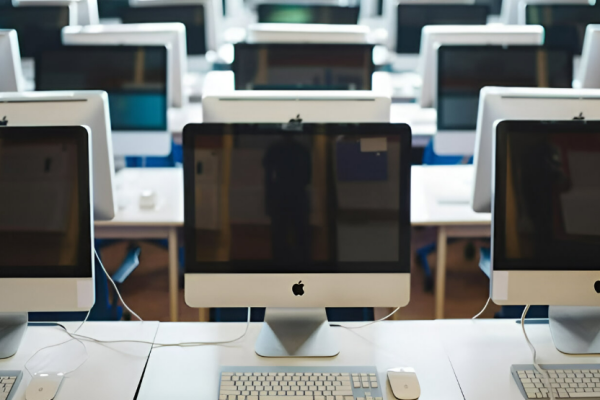What Happened to Smart Boards
As a freshman coming from Bell, I often take note of the obvious differences between Greeley and my former middle school, such as our campus’ resemblance to that of a shrunken college and the ability to order customized sandwiches and salads for lunch. But there are more subtle differences, too, that I have only recently discovered, and among them is the mysterious absence of SMARTboards.
In 2019, Greeley began swapping out its SMARTboards in favor of BenQ boards. While these boards may go unnoticed by a majority of students whose only interaction with them is during instructional time, some students have begun to explore the BenQ boards’ technological capabilities. As a frequent visitor to the GLC, I often see groups of people in breakout rooms using the boards to cast video games, stream videos, or create drawings, which range from crude, scrawled landscapes to intricate portraits of various politicians. People have even utilized the boards as a medium to lament about their struggles with AP classes, voicing their fears of the treacherous final exam through drawings and messages left on the screen.
Quite obviously, though, the district did not make this change for unique student artistry. Improvement to classroom technology and projection capabilities has long been a priority of the Technology Department.
The boards produced by SMART Technologies have failed to keep up with the latest online software. Updates from the manufacturers have been sparse and much of the technology remains unchanged. Mr. Culwell-Block, the district’s Director of Technology, Innovation, and Mathematics, explains that all SMARTboards in the district are still projector-based, producing various complications – images that are too dark or unclear, for example. BenQ boards, by contrast, are principally TV-based, which is a significant improvement that gets the district more bang for its buck. “Screen-based SMARTboards are quadruple the cost of screen-based BenQ boards,” Mr. Culwell-Block states.
Culwell-Block explains that BenQ boards are also much more functional, enabling teachers to wirelessly cast videos, slides, and more — a function that SMARTboards largely lack. In fact, according to Mr. Culwell-Block, only SMART Notebook, a piece of SMART proprietary software, can be run on the district’s current SMARTboards. BenQ boards come with their own built-in applications and an indispensable ability to display content from teachers’ computers, all-around trumping their “not-so-SMART” counterparts.
BenQ boards also come in three size variants: 64,” 72,” and 86.” This variation in size makes the boards more versatile in terms of both where they can be placed and how they may be used. Many breakout rooms, for example, are now fitted with 64” BenQ boards so that students can break out to make small-scale group presentations without disturbing others. The large board dominating the wall near the librarians’ desk in the GLC is an 86” board, more suitable for large presentations by teachers to a whole class.
Like all things, however, there are certain issues that Mr. Block and the district would like to see fixed with later iterations of the BenQ boards. While the boards come with built-in apps, many teachers rarely use them in class, if at all. Teachers have encountered numerous issues when trying to operate these apps, despite BenQ’s initial assurance that they would work perfectly. Nevertheless, teachers’ reviews of the BenQ have been generally positive, Mr. Culwell-Block notes.
He also remarked that cords and cord placement have been a problem; teachers in the school often share rooms and frequently have to unplug cords to shift things around – forgetting to plug them back in when done. This, however, was also an issue present in SMARTboards, so Mr. Culwell-Block does not see it as a particular disadvantage to adopting BenQ. Finally, Mr. Culwell-Block adds that more touch points and ports on BenQ screens and fronts, respectively, would be appreciated.
Mr. Block comments on his personal opinion on the change. “It’s a very worthwhile upgrade,” he says. He explains that when the building had undergone renovation, most of the SMARTboards were naturally replaced with BenQ boards, which is why areas that have yet to be renovated, such as the classrooms between the Academic Commons and L Building, still have either SMARTboards or projectors serving as their displays. Mr. Culwell-Block affirmed that the cost of the upgrade is greatly outweighed by the benefits both teachers and students have enjoyed because of it.
The students, too, seem to view the change quite positively – but even then, they also have encountered problems. When asked, Jordan Lupatkin, a freshman, reports that “the BenQ boards are good, but the one thing is that it’s hard to connect with certain computers, such as Chromebooks.” Perhaps the district will seek to resolve this issue, along with others described above, so that both students and teachers may enjoy this technology without experiencing glitches or connection problems.
But what does the future hold for the BenQ boards that have made their sudden entrance into Greeley classrooms? Mr. Culwell-Block mentions that the district is considering mounting the boards on carts in an effort to make classrooms more configurable. “The boards take up a lot of real estate on the wall,” he says. “With carts, if you don’t need to use it, you can just move it out of the way.” Another benefit of coupling the boards with carts is the added dynamism of a classroom: “If I walk into a classroom, I shouldn’t be able to see where the front of the room is,” Mr. Culwell-Block explains.
In fact, the district has already begun this process of mobilizing the BenQ boards: a cart mounted BenQ board is already present in room K104. The district also plans to grant two more such boards to the mathematics department and one to the science department, seeking to install more BenQ boards in all six schools across the district. Eventually, they plan to mobilize most, if not all, the boards. Mr. Culwell-Block also estimates that there are at least 10–20 SMARTboards remaining in each school. While it is for this reason that the conversion may be hard on the district’s budget, it is expected to be a worthwhile investment.
If Greeley keeps the BenQ boards, it is unlikely that upgrades will be needed—at least, not to the boards themselves. Experiments by teachers with the boards have revealed that placing an Apple TV behind the boards somehow increases the screen’s resolution. “This has been a game changer,” notes Mr. Culwell-Block. In fact, it reduces the cost of upgrading by a considerable amount, as a new Apple TV only costs a mere $125 in comparison to the $3,140 it takes to purchase a new BenQ board.
However, a new challenger has recently appeared on the horizon: boards produced by California-based electronics company ViewSonic have received extremely positive feedback from experimenting teachers – “They love it,” says Mr. Block. And this new love is not without reason. Mr. Culwell-Block explained that the ViewSonic has the revolutionary feature of only needing one cord to support touch, display, and power. This, quite obviously, is a rather apt solution to the persistent “cord entanglement” problem that has been present in both SMART and BenQ boards. Greeley students and faculty may very well soon see the replacement of classroom BenQ boards with those produced by ViewSonic, though Mr. Culwell-Block did not disclose how soon this may be.
Still a burning question remains: What really happened to the school’s SMARTboards?
The answer is that they have been auctioned off by the school board. As surprising, or unsurprising, as this may seem, the school has, in fact, been auctioning off old pieces of technology for years through Auctions International, an organization that helps agencies and businesses sell surplus items through their online platform. Mr. Culwell-Block reports that the district has been doing this with old computers too: “[The board] declares the technology obsolete, and then we auction them.” The district sends Auctions International a full list of what they have to offer and, eventually, those items – whether they be old Chromebooks or hefty SMARTboards – are auctioned off. “We sell it for as much value as we can get for it,” Mr. Culwell-Block affirms.
Though it is often difficult to bid farewell to many things in our lives, the fact is that humans are making constant efforts to advance ourselves. Doing away with the old and welcoming the new is often a necessary step in our persistent pursuit of progress.
Though I myself remember SMARTboards with great fondness—it was always magical when my elementary and middle school teachers invited me up to plaster my illegible scrawl on the screen —we must recognize that a school district must not remain stagnant in the array of devices its classrooms are equipped with. Displays have become an increasingly necessary utility and, by enhancing them, Chappaqua in turn enhances the quality of the education that their schools can provide. With progress and innovation as the north star, through the adoption of BenQ, Chappaqua continues to bestow the best possible education upon their thousands of students.










